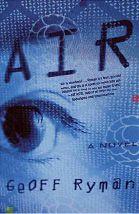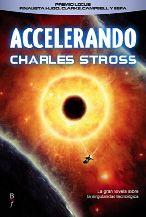Science Fiction: The 101 Best Novels 1985-2010 (43 page)
Read Science Fiction: The 101 Best Novels 1985-2010 Online
Authors: Damien Broderick,Paul di Filippo

80
Geoff Ryman
(2005)

GEOFF RYMAN
is a notably adventurous writer straddling the boundaries of science fiction, fantasy, slipstream, experimental writing, queer-inflected fiction and, recently, “Mundane” sf. His work is poignant, dense with detail, requiring a concentrated reading—yet it has a luminous clarity and humanity that’s brought him awards and acclaim in Britain (his adopted base), the USA, and Canada (his birthplace).
The Child Garden
(winner of the 1990 Arthur C. Clarke and Campbell Memorial awards), Ryman’s superb novel of genetic engineering, came close to being the long-awaited work successfully bonding the force and aspirations of both literature and sf.
Air
, winner of the Clarke, the Tiptree, and the British Science Fiction Association awards, belongs to the same shortlist of candidates.
This grittily realist, soaringly fantastical story of Mrs. Mae Chung, a robust middle-aged woman and mother of grown children in the imaginary nation of Karzistan, bordering China and Kazakhstan, inverts almost every aspect of
The Child Garden
. It moves in a pavane amid the balanced forces of the
I Ching
and other divinatory manifestations of the four ancient elements: air, fire, water and earth. Kizuldah, the Happy Province of rural peasants, is saturated in its own past, even as the flood of a belated today and then an instantaneous tomorrow crams memory into ruinous mud while its insistent presence invades poor Mae’s mind like a plague of memetic computer viruses.
Air is the next technology after the Internet, 2020’s mercantile version of what sf has long postulated—access to a group or gestalt mind. It is Google in the head, without need of chips, display, data gloves or keyboard, Theodore Sturgeon’s and Joe Haldeman’s gestalt connectivity for the age of quantum superspace and petaflop computation. It is the all-at-once of M-Theory’s timeless unity of space and change, accessed via a Format burned into the brain that—in trial runs in Karzistan, Tokyo and Singapore—uses an under-construction UN software template.
Unluckily, the Format test suggests that it is liable to disrupt and even madden unprepared brains exposed even briefly to Air’s 11-dimensional ubiquity. The rival, slower Gates Format struggles for preferment, seizing eagerly on the UN test’s collateral damage. From the big centers of power among the Western Haves, these global contests cascade in surprising ways over the ill-equipped but richly complex social arrangements of the Have Nots—who, naturally enough, bitterly resent being labeled as such by their patronizing benefactors.
Local fashion-advice specialist (and dirt-grubbing farmer) Mrs. Chung is perhaps the most extreme victim of these side-effects. In the moment of formatting, an elderly, blind, sweet-natured neighbor dies in her arms, so their minds become entangled. With typical comic bravura, Ryman explains that this is because they share an email address in the timeless realm of Air. Mae Chung’s personality is infused with the dead Mrs. Tung’s yearnings and her now forever-unchangeable history, like one infested by a dybbuk or demon.
A secondary effect of her unique immersion in Air is enhanced creativity. Mae gains access to the world’s plenty, learning to use the old-fashioned Web via a classy digital TV to contact markets for her fashion business, which soon goes global. This clever, illiterate woman’s faltering but growing competence is delightful to watch. Her naivety allows her to promote her wares with flyers teaching a women’s circle of fellow villagers
HOW TO MAKE BIG BUCKS FROM INFO
for this is the last corner of the world not yet awash in spam. Ryman has stressed that the setting is wholly invented, although it owes something to his experience of Turkey. The village of sinewy Karz peasants and tolerated, beautiful but delicate Eloi is richly evoked, utterly believable.
Because
Air
is authentic literature, Mae’s emotional involvements, her love affairs, her friendships and their subtle or brutal ebbs and flows, form the tense focus of the narrative. Still, to a degree no mundane novel could permit, the fanciful sf element of Air plays an equally compelling and impelling role. Echoing the tidal disruption that Air’s full implementation threatens, the very snows of the high places cupping the village hang at the edge of melting and flood. It is a threat only Mae and her memorious but increasingly spiteful ghost can detect. Mae knuckles down in face of this threat, learns meteorological arcana and bullies her way to the expensive software needed to interpret the local weather data she and her charge laboriously gather. As water rushes finally across earth, the fire of her unstoppable will snatches many of her mocking fellows to a redemptive safety that only an Air-powered bodhisattva could have managed.
Against this hard-headed peasant empiricism, Mae’s immersion in Air reveals reality’s mutability under desire. She rips asunder a wire fence by a sort of quantum magic: “The fence was mere fiction. So she tore it.” By the same means, an absurd, even grotesque, miracle brings Mae a pregnancy like nothing seen since the age of myth and legend. Mae is a sort of paradoxical Virgin Mother figure, and her joyous son, scalded and blind like Mrs. Tung but awash in Air’s music and light, is a sort of Redeemed New Human/Buddha/Christ, conceived in a loving, sexual feast. Yet the novel itself rejects interpretation:
“Everything has always been and has always happened at once. Which means nothing causes anything else. Which means stories only happen in this poor balloon-world of ours. Stories have no meaning. Nothing can be interpreted. Everything just is, without meaning.... It is all just one big smiling Now.”
The wondrous art wrought in Ryman’s
Air
shows some of its meaning plainly, calling forth grins, astonishment and tears. More of its meaning is tucked away inside, like the hidden curled-up dimensions of M-Theory’s spacetime, and (resembling
The Child Garden
in its closure) like the final pages of the third book of Dante’s
Divine Comedy
, beyond words or imagining high and low.
81
Charles Stross
(2005)

LIKE GREG EGAN
a decade earlier, Charles Stross seemed to come from nowhere and leap immediately to the top rank of science fiction and fantasy writers. This is an illusion in both cases (each had published early short fiction), but especially so for Stross, who for years pounded on many dozing publishers’ doors with several exciting book manuscripts before
Festival of Fools
was eventually bought by Ace, released as
Singularity Sky
, and went straight on to the Hugo ballot for best novel of the year. As did his audacious post-Singularity novelette “Nightfall” (poking its tongue out at Asimov’s most famous title). Neither won, but it was a remarkable debut.
Stross’s work has proved enormously popular, and justly so. With
Accelerando
, the quasi-novel compilation of his sequence of nine astonishing stories from
Asimov’s,
begun in 2001 with “Lobsters,” Charles Stross was sealed as the new Poet Laureate of the Vingean technological singularity. “Elector,” the penultimate chapter, was on the 2005 Hugo shortlist for best novella, which made a total of four Hugo nominations, one Nebula nomination, two Sturgeons, one BSFA, and a Seiun shortlisting before
Accelerando
was published. It won the 2006 Locus award for the year’s best novel. By the middle of the first decade of this century, Charles Stross was no longer just the sf writer to watch—he had well and truly arrived. In 2009, he became the first author to have a novel on the Hugo shortlist in six consecutive years, and in 2010 both a novella and a novelette on the ballot.
The
Accelerando
project’s five years of development (it is tempting to apply this sort of corporate language to Stross’s dense techno-speak art-artifact) yielded an early twenty-first-century counterpart to John Brunner’s compressed future shock 1969 Hugo-winner,
Stand on Zanzibar,
complete with rich idiomatic sidebars or side loads of Baedeker guidance to the non-native.
The rogue corporation rears up slightly and bunches into a fatter lump; its skin blushes red in patches. “Must think about this. Is your mandatory accounting time-cycle fixed or variable term? Are self-owned corporate entities able to enter contracts?”
That’s funny, and fun, as well as knowing. Some readers complain of infodumping of the most blatant kind, yet that device seems unavoidable when a torrential cascade of novelty is the very topic of a work of art. Approached with an appreciative generosity of response, these dollops of data are tight, compressed, inventive, brilliantly illuminated gems, or perhaps genomes (or memomes) that will unfold, in a prepared mind, into wondrous ecologies of image and idea. The changes implied by headlong acceleration are by definition too immense, too subtle, to be portrayed or perhaps even imagined. Stross has the audacity and, luckily for us, the imagination to come close to pulling it off.
Manfred Macx is a venture altruist (“Manfred’s on the road again, making strangers rich”)—Stross is not afraid to have us smile even as he jolts our preconceptions—a decade or so hence, encrusted with computer wearables and the latest wifi connectivity, affianced until recently to Pamela, a dominatrix headhunter for the IRS who tries to persuade global megacorps to cough up the tax they owe. Their venomous bond is manipulated sardonically by their robot cat, Aineko, which is being hacked and upgraded on the sly by Pamela. This nicely observed android animal—“It sits on the hand woven rug in the middle of the hardwood floor with one hind leg sticking out at an odd angle, as if it’s forgotten about it”—might be the secret narrator of the novel. Its augmentation and expansion toward the condition of a low-level demiurge mirrors the transitions of humankind and our posthuman Vile Offspring.
In a bondage scene of hilarious erotic vividness, Pamela gets herself pregnant with their daughter Amber, who will carry much of the long arc of the story to the Singularity and beyond, as human minds export themselves increasingly outside the skull into machine substrate exocortices. In turn, Amber’s son Sirhan (well, son of one of her many instantiations) takes the generational saga to the destructive
Childhood’s End
-style transcension of the solar system into a Matrioshka Brain (energy-hungry Dyson shells of computronium hosting untold trillions of superminds), the return from death of an extremely augmented Manfred, and a blind plunge beyond the provincial Milky Way to a realm where a galactic superintelligence seems to be mounting a “timing channel attack on the virtual machine that’s running the universe, perhaps, or an embedded simulation of an entirely different universe.”
It is typical of Stross’s full-on method that he declines to define “timing channel attack,” which is a sneaky method of undermining encryption by observing how long it takes to complete various aspects of the coding or decoding process. That doesn’t matter, nor should there be any problem in the book’s inundation of references from a dozen or a hundred different disciplines, not least Internet lore, mined by his jackdaw and inventive mind. This is how high bandwidth science fiction works. If some item baffles you, rush on and rejoice in the confusion. Or, if you are obsessive, Google it.